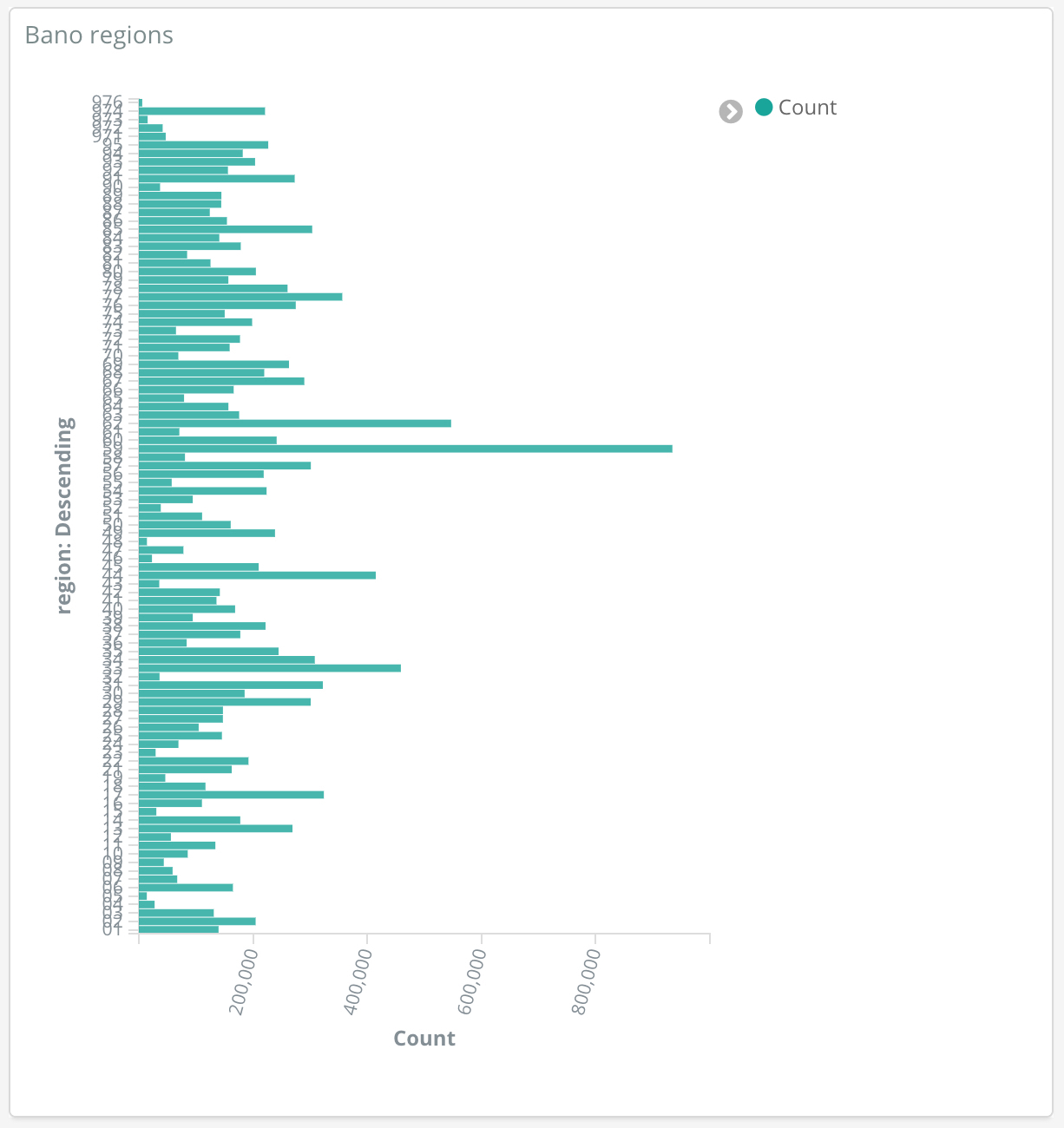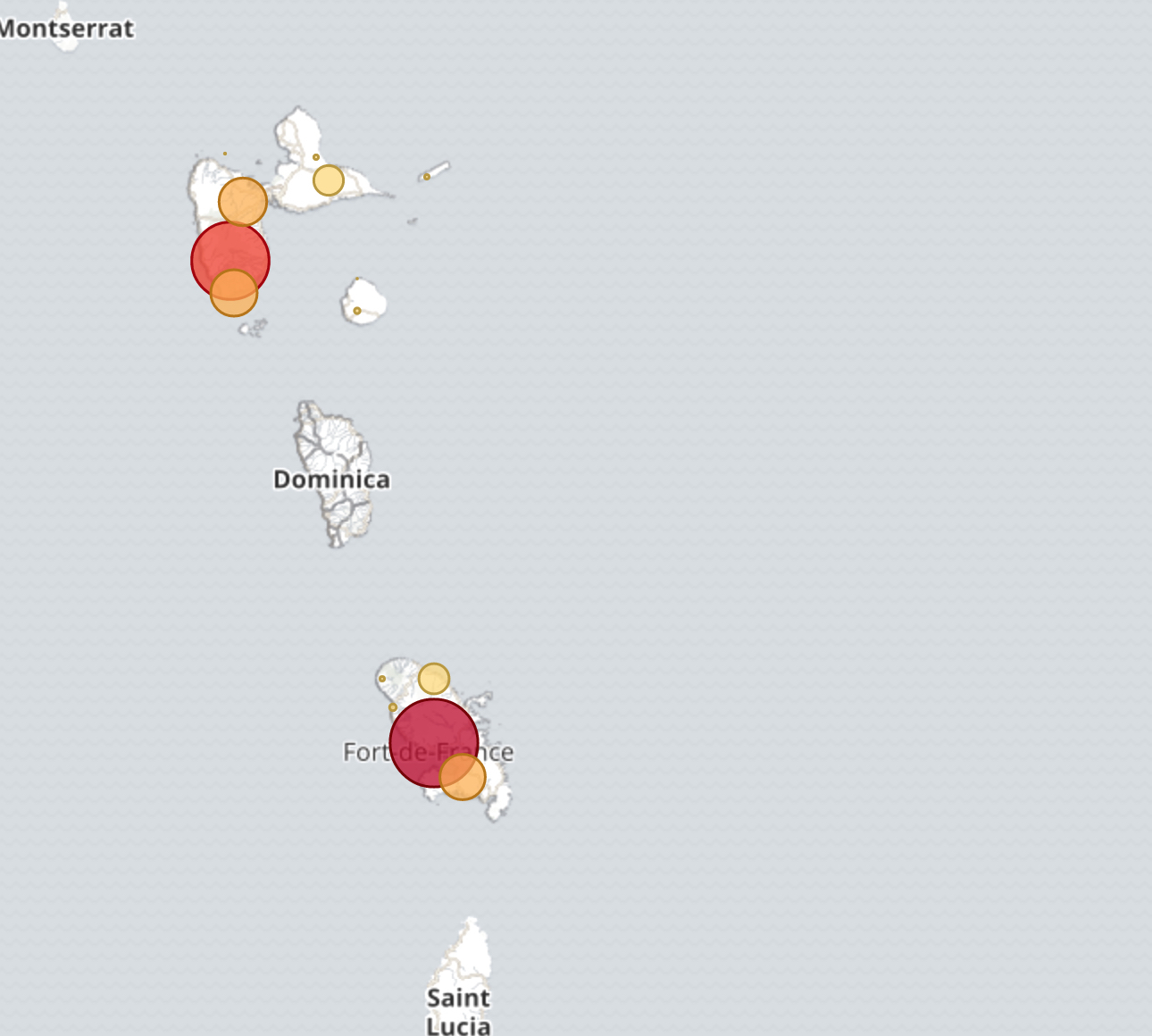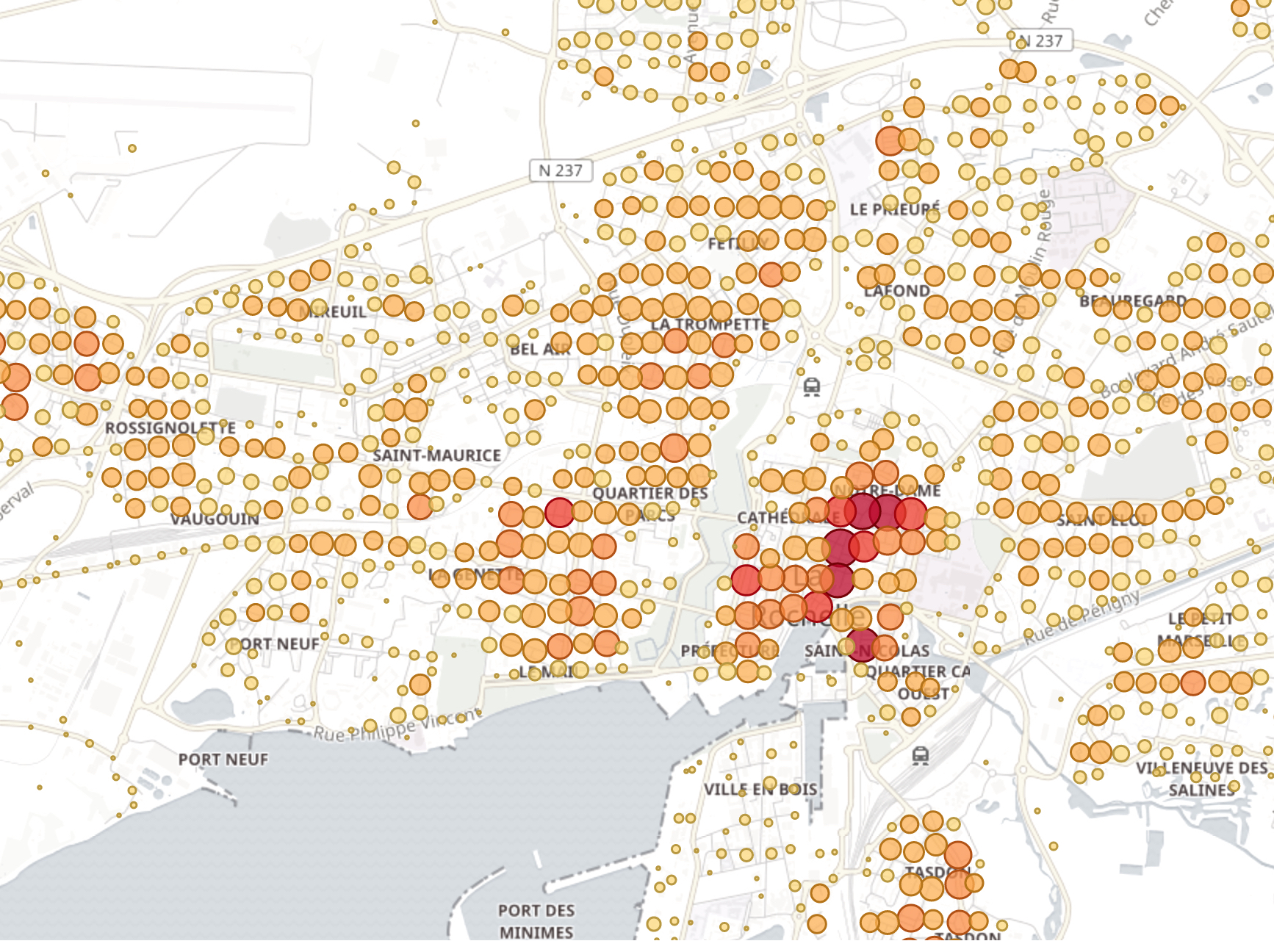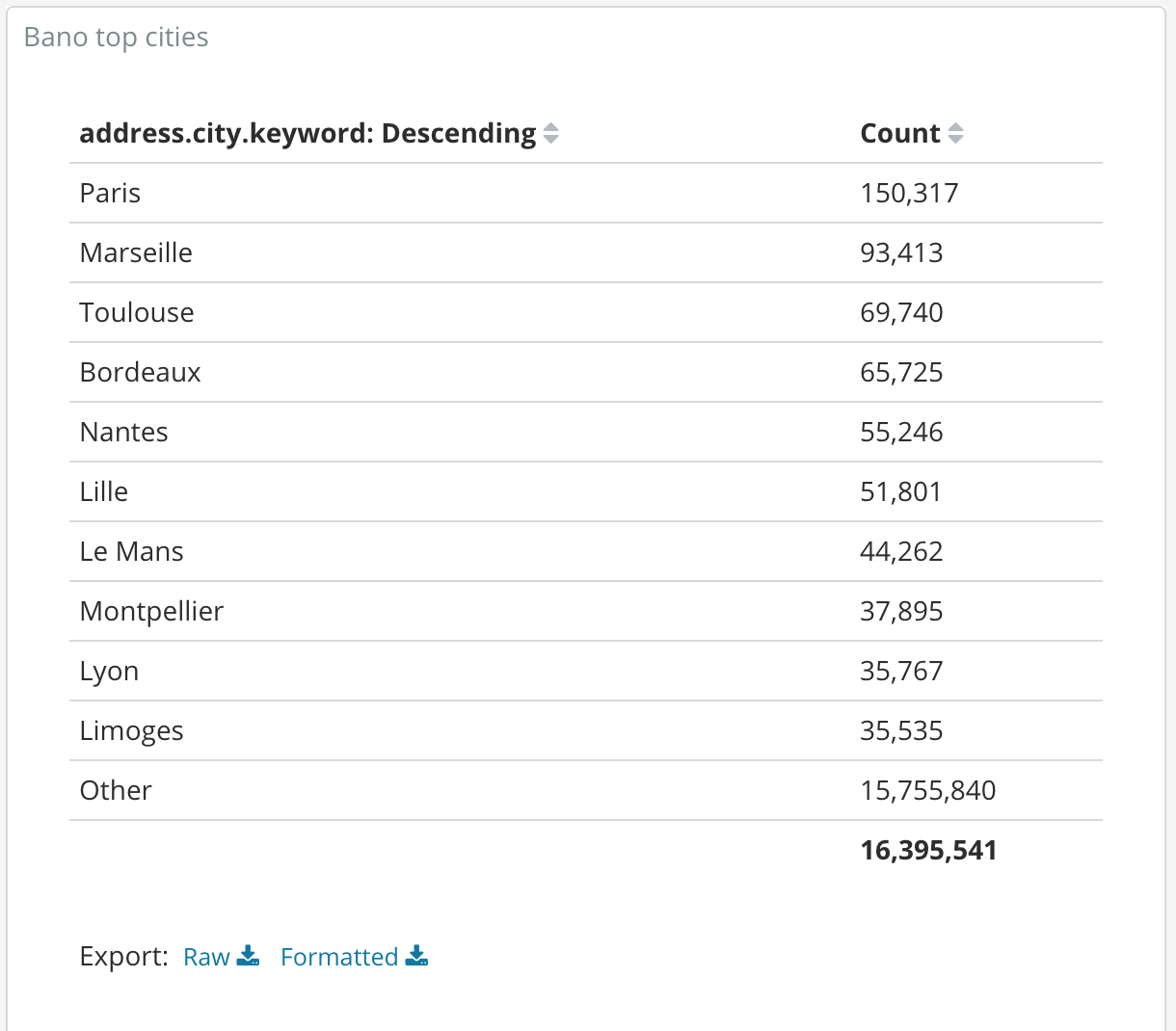
This blog post is part of a series of 3:
- Importing Bano dataset with Logstash
- Using Logstash to lookup for addresses in Bano index
- Using Logstash to enrich an existing dataset with Bano
I’m not really sure why, but I love the postal address use case. Often in my career I had to deal with that information. Very often the information is not well formatted so it’s hard to find the information you need when you have as an input a not so nice dataset.
Let’s take a simple use case. I have a user in my database like:
{
"name": "Joe Smith",
"address": {
"number": "23",
"street_name": "r verdiere",
"city": "rochelle",
"country": "France"
}
}
If you live in France you might notice that this address is fairly incomplete.
If we want to send a letter to Joe, it’s going to be hard.
Also, I’d really like to display on a map, where my customers are located in France.
On the other way around, let’s say I’m collecting data from a mobile application where I’m meeting friends and I’d like to remember automatically what was the address of the location last time we met. Basically I have data like:
{
"name": "Joe Smith",
"location": {
"lat": 46.15735,
"lon": -1.1551
}
}
And I would like to get back the postal address matching this location.
What can we do for that?
We need something to enrich the existing data by fixing the address and providing actual coordinates or the other way back.
Bano
We can use something like the Google Map API for that and do an external call anytime we need, but I see 2 major pain points here:
- We need to communicate with an external service and may be your company policy does not allow sending to an internet service some private data like your customers data.
- You might suffer from some latency anytime you want to call that external service on which you can’t really have any knob to make it faster. Speed light is speed light and crossing the ocean may be will always include some latency.
We need something local then. In France, we are super lucky because we have a public dataset named BANO
as Base d'Adresses NatiOnale (National Address Database) provided under the Open Street Map
umbrella.
This project exports everyday the list of known addresses anywhere in France. Here is an extraction of what you can have:
-rw-r--r--@ 1 dpilato staff 11183891 27 nov 02:03 bano-88.csv
-rw-r--r--@ 1 dpilato staff 25014545 27 nov 02:04 bano-85.csv
-rw-r--r--@ 1 dpilato staff 3888078 27 nov 02:04 bano-971.csv
-rw-r--r--@ 1 dpilato staff 12107391 27 nov 02:04 bano-92.csv
-rw-r--r--@ 1 dpilato staff 3443396 27 nov 02:04 bano-972.csv
-rw-r--r--@ 1 dpilato staff 1218424 27 nov 02:05 bano-973.csv
-rw-r--r--@ 1 dpilato staff 455986 27 nov 02:05 bano-976.csv
-rw-r--r--@ 1 dpilato staff 21634994 27 nov 02:05 bano-91.csv
-rw-r--r--@ 1 dpilato staff 15848802 27 nov 02:05 bano-93.csv
-rw-r--r--@ 1 dpilato staff 14779208 27 nov 02:05 bano-94.csv
-rw-r--r--@ 1 dpilato staff 17515805 27 nov 02:06 bano-95.csv
-rw-r--r--@ 1 dpilato staff 17713007 27 nov 02:07 bano-974.csv
-rw-r--r--@ 1 dpilato staff 71133336 27 nov 02:08 bano-59.csv
Each CSV file correspond to a subdivision of France that we call a department. It’s like a region but smaller. Bigger than a city though.
Download Bano CSV files
I wrote a simple shell script to download locally all the files I needed but you can directly consume from Logstash one CSV file with an http_poller plugin.
#!/bin/bash
set -e
download () {
wget http://bano.openstreetmap.fr/data/$1 --timestamping --directory-prefix=bano-data -c --no-verbose --show-progress
}
DEPTS=95
for i in {01..19} $(seq 21 $DEPTS) {971..974} {976..976} ; do
DEPT=$(printf %02d $i)
echo Downloading bano department $DEPT
download bano-$DEPT.csv
done
What is happening with numbers here?
Well, France is a moving country. Sometimes departments are merged all together which probably explains why we don’t have anymore a department 20.
Some department of France are also located far far away from the french metropolitan area. Those are labelled as 97x.
Nothing can be simple in France 😅.
Loading elasticsearch
Let’s now parse the data and load that in elasticsearch, so we will be able to search for addresses.
If we look at one of the CSV file, we can see:
976030950H-26,26,RUE DISMA,97660,Bandrélé,CAD,-12.891701,45.202652
976030950H-28,28,RUE DISMA,97660,Bandrélé,CAD,-12.891900,45.202700
976030950H-30,30,RUE DISMA,97660,Bandrélé,CAD,-12.891781,45.202535
976030950H-32,32,RUE DISMA,97660,Bandrélé,CAD,-12.892005,45.202564
976030950H-3,3,RUE DISMA,97660,Bandrélé,CAD,-12.892444,45.202135
976030950H-34,34,RUE DISMA,97660,Bandrélé,CAD,-12.892068,45.202450
976030950H-4,4,RUE DISMA,97660,Bandrélé,CAD,-12.892446,45.202367
976030950H-5,5,RUE DISMA,97660,Bandrélé,CAD,-12.892461,45.202248
976030950H-6,6,RUE DISMA,97660,Bandrélé,CAD,-12.892383,45.202456
976030950H-8,8,RUE DISMA,97660,Bandrélé,CAD,-12.892300,45.202555
976030950H-9,9,RUE DISMA,97660,Bandrélé,CAD,-12.892355,45.202387
976030951J-103,103,RTE NATIONALE 3,97660,Bandrélé,CAD,-12.893639,45.201696
\_ ID | \_ Street Name | \ \_ Source \_ Geo point
| | \
|_ Street Number |_ Zipcode \_ City Name
Writing the Logstash pipeline
As everytime I’m writing a Logstash pipeline, I’m always starting with a basic configuration file, let’s call it bano-data.conf:
input {
stdin { }
}
filter {
}
output {
stdout { codec => json }
}
Let’s run it:
head -1 | logstash-6.2.3/bin/logstash -f bano-data.conf
This gives something like:
{
"message":"976030951J-103,103,RTE NATIONALE 3,97660,Bandrélé,CAD,-12.893639,45.201696",
"@timestamp":"2017-12-05T16:00:00.000PST",
"@version":1,
"host":"MacBook-Pro-David.local"
}
Let’s add our csv-filter plugin as we already saw in Exploring Capitaine Train dataset
:
csv {
separator => ","
columns => [
"id","number","street_name","zipcode","city","source","latitude","longitude"
]
remove_field => [ "message", "@version", "@timestamp", "host" ]
}
That’s now producing:
{
"source":"CAD",
"id":"976030951J-103",
"number":"103",
"street_name":"RTE NATIONALE 3",
"zipcode":"97660",
"city":"Bandrélé",
"latitude":"-12.893639",
"longitude":"45.201696"
}
Let’s rename and convert some fields with the mutate-filter plugin:
mutate {
convert => { "longitude" => "float" }
convert => { "latitude" => "float" }
rename => {
"longitude" => "[location][lon]"
"latitude" => "[location][lat]"
"number" => "[address][number]"
"street_name" => "[address][street_name]"
"zipcode" => "[address][zipcode]"
"city" => "[address][city]"
}
replace => {
"region" => "${REGION}"
}
}
I’ll explain a bit later where this ${REGION} value is coming from.
But basically, I want to store here the department number the address is coming from.
This now gives:
{
"source":"CAD",
"id":"976030951J-103",
"region":"976",
"address":{
"number":"103",
"street_name":"RTE NATIONALE 3",
"zipcode":"97660",
"city":"Bandrélé"
},
"location":{
"lat":-12.893639,
"lon":45.201696
}
}
We are almost done. Let’s load elasticsearch now by adding our elasticsearch-output plugin:
elasticsearch {
"template_name" => "bano"
"template_overwrite" => true
"template" => "bano.json"
"index" => ".bano-${REGION}"
"document_id" => "%{[id]}"
}
Few things to explore in that last code sample:
- We are providing an index template for elasticsearch.
- We are setting the
_indexname to.bano-${REGION}. Again, we will explain later where this value is coming from. - We are setting the document
_idto theidprovided within the bano dataset.
Bano index template
As you can notice, we are using an index template here named bano which is loaded by logstash anytime the elasticsearch plugin starts. Using template_overwrite helps overwriting the template anytime you want to change some rules. Of course, overwriting an index template does not update the existing indices. So basically you will need to drop the existing indices and parse again the bano data with Logstash.
Let’s describe what this index template contains:
{
"template": ".bano-*",
"settings": { /* ... */ },
"mappings": { /* ... */ },
"aliases" : { /* ... */ }
}
This template will be applied anytime we have an index which name starts with .bano-. We will then apply 3 following parts:
settings: for index settingsmappings: for document mappingaliases: for virtual indices (aka aliases)
The settings part is the following:
{
"template": ".bano-*",
"settings": {
"index.number_of_shards": 1,
"index.number_of_replicas": 0,
"index.analysis": {
"analyzer": {
"bano_analyzer": {
"type": "custom",
"tokenizer": "standard",
"filter" : [ "lowercase", "asciifolding" ]
},
"bano_street_analyzer": {
"type": "custom",
"tokenizer": "standard",
"filter" : [ "lowercase", "asciifolding", "bano_synonym" ]
}
},
"filter": {
"bano_synonym": {
"type": "synonym",
"synonyms": [
"bd => boulevard",
"av => avenue",
"r => rue",
"rte => route"
]
}
}
}
},
"mappings": { /* ... */ },
"aliases" : { /* ... */ }
}
Here, we want one single shard per index (per department) which is more than enough. We don’t want replicas as we will be running that on a single node.
Note The number of replicas can be set dynamically so after the ingestion of the bano data, we can always increase this value if we decide to have a bigger cluster.
We are then defining two analyzers. The first one, bano_analyzer, is a kind of a standard analyzer but with addition of an asciifolding token filter which will transform at index time and search time all the french diatrics like for example é, è, ê to their ascii equivalent value: e.
The second analyzer named bano_street_analyzer adds also some synonyms. Indeed, when I looked at some values we have in the bano dataset, I found that sometimes the same type of street has different type names. Like av for avenue.
The synonym token filter will definitely help to normalize that.
As it will be used also at search time, it will help if for example a call center operator type bd instead of boulevard as it will be also normalized to the right value.
The mappings part is the following:
{
"template": ".bano-*",
"settings": { /* ... */ },
"mappings": {
"doc": {
"properties" : {
"address": {
"properties" : {
"city": {
"type": "text",
"analyzer": "bano_analyzer",
"fields": {
"keyword": {
"type": "keyword"
}
}
},
"number": {
"type": "keyword"
},
"street_name": {
"type": "text",
"analyzer": "bano_street_analyzer"
},
"zipcode": {
"type": "keyword"
}
}
},
"region": {
"type": "keyword"
},
"id": {
"type": "keyword"
},
"source": {
"type": "keyword"
},
"location": {
"type": "geo_point"
}
}
}
},
"aliases" : { /* ... */ }
}
Everything is pretty much obvious here. For some fields we are using a keyword data type as we just want to run exact match or aggregations.
The street_name is using the bano_street_analyzer we saw before.
city is indexed twice:
- As
cityfield to perform full text search on it. - As
city.keywordfield to perform a terms aggregation on it.
Finally location is a geo_point type.
The aliases part is the following:
{
"template": ".bano-*",
"settings": { /* ... */ },
"mappings": { /* ... */ },
"aliases" : {
".bano" : {}
}
}
It means that if we don’t know the department when we have to search, we can search in .bano virtual index which will behind the scene query all bano indices. Of course, we could have been using a wildcard when searching as well like:
GET .bano-*/_search
Loading data
To launch our importation, let’s write a shell script:
import_region () {
export REGION=$1
FILE=bano-data/bano-$REGION.csv
curl -XDELETE localhost:9200/.bano-$REGION?pretty
cat $FILE | logstash-6.2.3/bin/logstash -f bano-data.conf
}
DEPTS=95
for i in {01..19} $(seq 21 $DEPTS) {971..974} {976..976} ; do
DEPT=$(printf %02d $i)
import_region $DEPT
done
We are using here the same tricks for the strange department numbers.
In import_region we are exporting the department number as REGION system property which logstash is then able to use.
For each CSV file, we basically:
- Remove the existing index if any
- cat the content of the file and send the content to Logstash
We could have been a bit smarter and we could have been using instead an http input plugin which just waits for documents coming on port 8080. We will cover that in a next section.
It took something like 2 hours and a half to inject the data on my laptop but I now have data ready…
Bano statistics
So what do we have now?
GET _cat/indices/.bano*?v&h=index,docs.count,store.size
Gives (only the first lines are shown here):
index docs.count store.size
.bano-80 204930 20.7mb
.bano-50 160820 16.4mb
.bano-60 241276 24.6mb
.bano-34 308056 30.9mb
How many addresses do we have?
GET .bano/_search
{
"size": 0
}
Gives:
{
"took": 24,
"timed_out": false,
"_shards": {
"total": 99,
"successful": 99,
"skipped": 0,
"failed": 0
},
"hits": {
"total": 16402853,
"max_score": 0,
"hits": []
}
}
So we have 16.402.853 addresses.
Let’s look at that from Kibana. Here I built really simple visualizations.

Distribution of Bano addresses by department number

Map of Bano addresses for France Metropolitan

Map of Bano addresses for some France Overseas Departments

Map of Bano addresses near by La Rochelle

Top cities (in number of known addresses
No surprise in this list. It’s common to say that biggest cities in term of population are:
- Paris
- Marseille
- Toulouse
- Bordeaux
- Nantes
Next steps
Have a look at the next post to see how you can now use that dataset to perform address correction and transformation.
